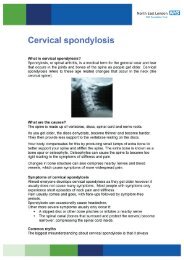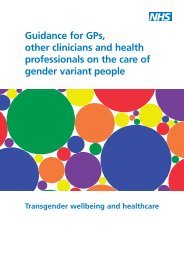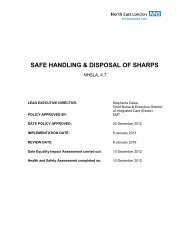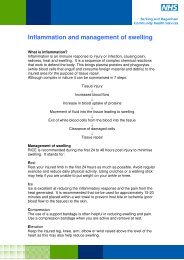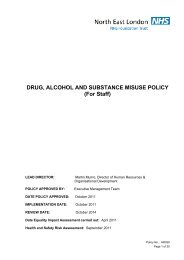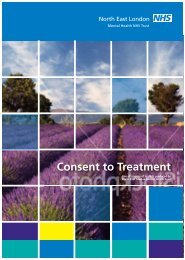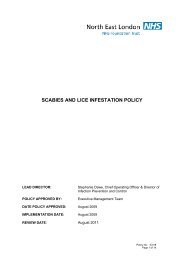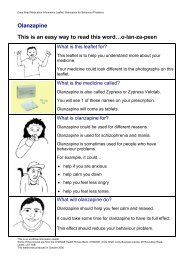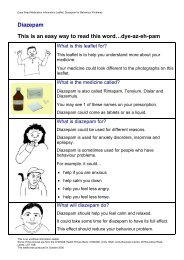(vte) policy - North East London NHS Foundation Trust
(vte) policy - North East London NHS Foundation Trust
(vte) policy - North East London NHS Foundation Trust
You also want an ePaper? Increase the reach of your titles
YUMPU automatically turns print PDFs into web optimized ePapers that Google loves.
NELFT- SWEC Community Hospital Inpatient Admission,transfer and discharge <strong>policy</strong>NELFT-SWEC Quality of Clinical Record Keeping <strong>policy</strong>NELFT – SWEC Venous Thromboembolism in CommunityInpatient Hospitals Protocol for the Prevention ofNELFT- Venous Thromboembolism (VTE) Guideline for thePrevention and Management of MHS and NELCSNELFT- NELCS Guideline for the Safe Administration andManagement of Patients on Anticoagulation Therapy(Draft v1)Amendments /dateIf draftDraft NumberComments to[only complete remaining boxes]Angela Sealyangela.sealy2@nhs.netPolicy No: TW/CL0026/v001 Page 3 of 27
1. Introduction1.1. Venous Thromboembolism (VTE) is the formation of a blood clot (thrombus) in a vein whichmay dislodge and cause an embolism. Most thrombi form in the deep veins of the legs andpelvis and are called deep vein thrombosis (DVT). Dislodged thrombi may travel to the lungs,Pulmonary Emboli (PE) and can be fatal. Thrombi can also cause long term morbidity such aspost thrombotic syndrome.1.2. The House of Commons Health Committee1 reported in 2005 that an estimated 25,000people die from preventable hospital-acquired venous thromboembolism (VTE) every year. Thisincludes patients admitted to hospital for medical care and surgical interventions. Risks ofthrombus formation increase with length of surgical procedures and increased periods ofimmobility.1.3. The inconsistent use of prophylactic measures for VTE in hospital patients has been widelyreported. A UK survey suggested that 71% of patients assessed to be at medium or high risk ofdeveloping a DVT did not receive any form of mechanical or pharmacological VTE prophylaxis.The National Institute of Clinical Excellence Clinical Guideline 92; Venousthromboembolism: reducing the risk offers best practice advice on reducing the risk of VTEin patients/service users admitted to hospital.2. AimThe aim of this <strong>policy</strong> is to ensure that all patients/service users are appropriately assessedfor their risk of developing a VTE, they receive appropriate prophylaxis and that the level ofrisk is reviewed throughout their stay in NELFT.3. Definitions3.1. Venous thromboembolism: (VTE)Venous thrombosis is a condition in which a blood clot (thrombus) forms in a vein in any partof the venous system.The thrombus can reduce blood flow through the affected vein, causing pain and swelling.3.2. Deep Vein Thrombosis (DVT)Venous thrombosis most commonly occurs in the ‘deep veins’ in the legs, thighs, or pelvis.This is known as a deep vein thrombosis (DVT).Policy No: TW/CL0026/v001 Page 5 of 27
3.3. EmbolismWhen a part or all of the thrombus in the deep vein breaks off from the site where it iscreated and travels through the venous system. This is known as an embolism.3.4. Pulmonary embolism (PE)A dislodged thrombus that travels to the lung is known as a pulmonary embolism (PE).However, deep vein thrombosis (DVT) and PE are the most common manifestations ofvenous thrombosis. DVT and PE are known as venous thromboembolism (VTE). (DH, 2009)3.5. ThromboprophylaxisThromboprophylaxis is the treatment to prevent blood clots forming in veins.3.6. NELFT<strong>North</strong> <strong>East</strong> <strong>London</strong> <strong>Foundation</strong> <strong>Trust</strong>3.7. NELFT Business Units<strong>North</strong> <strong>East</strong> <strong>London</strong> Community Services (NEL CS), South West Essex Community Services(SWECS) and Mental Health Services (MHS).3.8. Clinical StaffThis relates to all registered nursing and medical staff working within a NELFT Communityor Mental Health Inpatients services.3.9. SOPStandard Operating Procedure4. Duties and Responsibilities4.1. Operational Directors within each NELFT Business UnitAre responsible for ensuring all managers are made aware of the content of the <strong>policy</strong>.4.2. ManagersManagers will then ensure that all staff at all levels within their department is made aware ofthe contents of this <strong>policy</strong>.Policy No: TW/CL0026/v001 Page 6 of 27
Matrons are responsible for ensuring that all patients receive a VTE risk assessment onadmission.4.7. PharmacistsPharmacists have a responsibility to ensure that thromboprophylaxis medication, dosageand route are appropriate for the patient/service user.Pharmacists must ensure that the VTE risk assessment and prescriptions ofthromboprophylaxis medication are congruous and inform the Doctors/Independentprecribers of any inappropriate prescriptions or drug interactions.5. Procedure for Risk Reduction and Prophylaxis5.1. All patients/service users admitted to NELFT must be screened for risk from VTE andconsidered for thromboprophylaxis using risk assessment screening tool (Appendix 1a & 1b)on admission or an alternative locally agreed assessment tool ( see separate business unitstandard operating procedures).5.2. The patient/service user should be reassessed for risk after 24 hours and during their inpatient stay as the patient/service user’s condition changes or weekly as a minimum.For care pathway see (Appendix 2) and for specific business units care pathways.The following documents must be read for specific business units care pathways for theprocedure to follow if VTE is suspected:For SWECS Inpatient Services – refer to NELFT – SWEC VenousThromboembolism in Community Inpatient Hospitals Protocol for the Prevention of.For MHS and NEL CS Inpatient Services– refer to NELFT- VenousThromboembolism (VTE) Guideline for the Prevention and Management of MHSand NELCS.5.3. Relevant risk factors are contained in the risk assessment screening tool (Appendix1a&1b). The identification of two or more risk factors during assessment indicates thepatient/service user to be at ‘high risk’ of VTE.5.4. Patients/Service Users who require prolonged admission (greater than one week)should have a weekly review of the VTE risk assessment and prophylaxis. For theprocedure to be followed if VTE is suspected please refer to:Policy No: TW/CL0026/v001 Page 8 of 27
6.8. Management of Patients with a positive VTE diagnosisFor SWECS Inpatient Services - refer to NELFT – SWEC Venous Thromboembolism inCommunity Inpatient Hospitals Protocol for the Prevention of.For MHS and NEL CS Inpatient Services – refer to NELFT- Venous Thromboembolism(VTE) Guideline for the Prevention and Management of MHS and NELCS6.9. Patient/Service User Information and ConsentAll patients admitted to NELFT to Inpatient settings will receive written patients/service usersinformation and exercise guide.For SWECS Inpatient Services patients/service users information and exercise guide - referto NELFT – SWEC Venous Thromboembolism in Community Inpatient Hospitals Protocol forthe Prevention of.For MHS & NEL CS Inpatient Services patients/service users information and exercise guide– refer to NELFT- Venous Thromboembolism (VTE) Guideline for the Prevention andManagement of MHS and NELCS6.10. For consent in all NELFT Inpatient settings refer to the NELFT Consent to Examinationand Treatment Policy 20117. Discharging patients/service users7.1. Upon discharge patients/service users nurses must include as part of the dischargeplan. Patients/Service Users and/or their families or carers verbal and written information on:signs and symptoms of DVT and PEthe importance of seeking medical help and who to contact if a DVT, PE or anotheradverse event is suspectedrefer to specific Business Units guidelines and protocols for the discharge process ineach business unit8. Process for implementation8.1 . Staff will be made aware of any new approved policies/procedures/guidelines viathe monthly team brief. Quality and patient safety team will be responsible forensuring newly approved documents are sent to the communications team in orderfor them to insert into the <strong>Trust</strong> team brief.8.2 . All senior managers/heads of service/team leaders need to ensure new policiesand procedures are placed on team meeting agendas for discussion. There is anPolicy No: TW/CL0026/v001 Page 10 of 27
expectation that the team leader will develop local systems to ensure their staff areinstructed to read all relevant policies and to identify any outstanding training deficits.9. Monitoring Arrangements9.1 The effectiveness of this document is monitored and reported through:Quarterly PCT contract performance reportAnnual report to <strong>Trust</strong> boardBusiness Units Performance Sub GroupsQuality & Patient Safety Performance Sub Group9.2Which part of<strong>policy</strong> to bemonitored (for<strong>NHS</strong>LAspecificpolicies referto thecriterion)Which part ofthe <strong>policy</strong>needs to bemonitored?(for <strong>NHS</strong>LAspecificpolicies referto thecriterion)Audit ofnumber ofcompleted VTEriskassessments ofpatients/serviceusers inInpatientservicesLead (JobTitle only)Who will bethe lead forensuringthismonitoringwork isundertaken?Matrons-InpatientservicesTool /methodHow will thismonitoring ofcompliancehappen?E.g. reviewof indicatorssuch astrainingcomplianceetcPatientSafetyThermometerauditFrequencyHow oftenwill thismonitoringbeundertaken?i.e. monthly/ quarterlyetcMonthlyWho willundertakeWho willundertakethismonitoring?A specificteam or willit beundertakenby clinicalandmedicalstaff?Clinicalstaff –inpatientservicesWhereresults willbe reportedWhere willthe resultsof themonitoringprocess bereported to?This couldincludebusinessunit groups,trust widegroups orcommitteesQuality &PatientSafetyPerformanceSub groupsBusinessUnitPerformanceSub groupsAudit ofinpatientpatient recordsfor evidence ofadherence to<strong>policy</strong>MedicalLeadReview ofcompletedVTE riskassessmentsin patientrecordswithintimescale inInpatientservicesQuarterlyMedicalStaffBusinessUnitPerformanceSub groupsQuality &PatientSafetyPerformanceSub groupsPolicy No: TW/CL0026/v001 Page 11 of 27
10. Standards/Key Performance indicatorsQuality standard for VTE – preventionThe quality standard for VTE – prevention applies to part of the care pathway for theprevention and management of VTE.Number Quality statements1 All patients, on admission, receive an assessment of VTE and bleeding risk using theclinical risk assessment criteria described in the national tool.2 Patients/carers are offered verbal and written information on VTE prevention as partof the admission process.3 Patients provided with anti-embolism stockings have them fitted and monitored inaccordance with NICE guidance.4 Patients are re-assessed within 24 hours of admission for risk of VTE and bleeding.5 Patients assessed to be at risk of VTE are offered VTE prophylaxis in accordancewith NICE guidance.6 Patients/carers are offered verbal and written information on VTE prevention as partof the discharge process.7 Patients are offered extended (post hospital) VTE prophylaxis in accordance withNICE guidance.11. Equality StatementThis <strong>policy</strong> reflects the organisation’s determination to ensure that all parts of our communityhave equality of access to services and that everyone receives a high standard of service asa service user, a carer or employee. This <strong>policy</strong> anticipates and encompasses the <strong>Trust</strong>’scommitment to prevent discrimination on any illegal or inappropriate basis and recogniseand respond to the needs of individuals based on good communication and best practice.We recognise that some groups of the population are more at risk of discrimination or lessable to access to services than others and that services can often unintentionally putbarriers in place that can limit or prevent access. The organisation is continually working toprevent this from happeningPolicy No: TW/CL0026/v001 Page 12 of 27
12. TrainingSpecific training for identified staff groups will be delivered in line with the current TrainingNeeds Analysis which is available on the Intranet.13. Other policies of relevanceNELFT Consent to Examination or Treatment Policy 2011NELFT Procedure for Assessment of Mental Capacity CP022 2010NELFT Implementation of Nation GuidanceNELFT- SWEC Community Hospital Inpatient Admission, transfer and discharge<strong>policy</strong>NELFT-SWEC Quality of Clinical Record Keeping <strong>policy</strong>NELFT – SWEC Venous Thromboembolism in Community Inpatient HospitalsProtocol for the Prevention ofNELFT- Venous Thromboembolism (VTE) Guideline for the Prevention andManagement of MHS and NELCSNELFT- NELCS Guideline for the Safe Administration and Management of Patientson Anticoagulation Therapy(Draft v1)14. External referencesHouse of Commons Health Committee (2005) The prevention of venous thromboembolism inhospitalised patients. <strong>London</strong>: The Stationary Office.Rashid ST, Thursz MR, Razvi NA et al. (2005) Venous thromboprophylaxis in UK medicalinpatients. Journal of the Royal Society of Medicine 98 (11); 507-12.NICE Clinical Guideline 92 Venous Thromboembolism: reducing the risk January 2010.National Institute for Health and Clinical Excellence.www.nice.org.uk/guidance/CP92/GuidanceNICE Quality Standard VTE Preventionhttp://www.nice.org.uk/guidance/qualitystandards/Vteprevention/Vtequalitystandard.jspPolicy No: TW/CL0026/v001 Page 13 of 27
Platelets 230/120)Untreated inherited bleeding disorder (such ashaemophilia and von Willebrand disease)On admission: Date/timeanaesthesia within the previous 4 hoursAdditional comments:See additional guidanceReview: Date/timeName:Signed:Risk assessment must be confirmed on admissionRisk of High risk of VTE with lowVTE bleeding risk(Tick)Refer to table 1 for recommended prophylaxisName:High risk of VTE withsignificant bleeding riskSigned:Low risk ofVTEPolicy No: TW/CL0026/v001 Page 16 of 27
Table 1 SURGICAL PATIENTS MEDICAL PATIENTSRisk of VTE Recommended Prophylaxis Recommended ProphylaxisHIGH(with low risk of bleeding)HIGH(with significant risk ofbleeding)LOWEnoxaparin 40 mg daily+TED stockings +/- Sequentialcompression device+Early mobilisationTED stockings +/- Sequentialcompression device+Early mobilisationEarly mobilisationEnoxaparin 40 mg daily+Early mobilisationTED stockings +/- Sequentialcompression device+Early mobilisation(do NOT use TED stockings in strokepatients)Early mobilisationCONTRAINDICATIONSEnoxaparinCrcl >30ml/min – use unfractionated heparin 5000units BDActive bleedingPlatelet count
situ,DBS insertion)devicePalliative care: Consider offering pharmacological VTE prophylaxis to patients care who havepotentially reversible acute pathology.Take into account potential risks and benefits, and the views of the patients and families/carers.Duration: Continue until mobility no longer significantly reduced.High risk orthopaedic patients should receive prophylaxis for at least 10 days. Elective kneereplacement should receive 14 days prophylaxis.Extended prophylaxis (28 days) is recommended for elective hip replacement, hip fracture andother selected high risk general surgery patients e.g. major cancer surgery.Obesity: Use Enoxaparin 40mg twice daily if body weight > 100kg (or 60mg bd if body weight >150kg)Policy No: TW/CL0026/v001 Page 18 of 27
Appendix 2VTE Care PathwayPatient/Service Useradmitted to hospitalAssess VTE riskWithin 4 hours of admissionAssess bleeding riskWithin 4 hours of admissionBalance risk of VTE and bleedingOffer VTE prophylaxis if appropriate.Do not offer pharmacological VTE prophylaxis if patient hasany risk factor for bleeding and risk of bleeding outweighrisk of VTE within 4 hours of admissionReassess risks of VTE and bleeding within 24 hours ofadmission and whenever clinical situation changesFor all patientsDo not allow patients/service users to become dehydrated unless clinically indicated.Encourage patients/service users to mobilise as soon as possible.Do not regard aspirin or other antiplatelets agents as adequate prophylaxis for VTE.Policy No: TW/CL0026/v001 Page 19 of 27
CommentsreceivedReturned, nocommentsNo responseList of all stakeholders consultedDate sent to Stakeholders: 14/12/12 Stakeholder response date: 21/12/12Stakeholder nameStakeholder titleAD QPSBansal HarjitBlum ShelleyBoon SueBorrett LesBrid Johnson (external)Bridger StephanieBright ChrisCarole HayesCarpenter BeccyChaloner JillDorney AdrianDoyle CarolynEdwards BobEl-Baze FrancesEllsmore NicolaFeast SteveFeatherstone LuenneGarrett AlisonGary TownsendGillian MillsGraham BlowesGrimes PamHaspel SarahHorne DavidJacqueline KavanaghJacqui Van RossumPolicy No: TW/CL0026/v001 Page 20 of 27
Jo LindoKhambhaita KrishnaKimmett IanLee ChesterMalcolm YoungMary CurrieMaryon BethMatthew MacdonaldMichelle StapletonMunro MartinNoll AlisonO'Connor StephenODonnell CarolinePav DevsiPhilomena ArthurPike JanePrice JulieRex ObengRossouw TrudieSarah RobertsSealy AngelaSearle DianeSharon ShelleySmith DebbieSmyth SusanSole KevinSrikumar SivasubramaniamThomas GrahamThomas PeterTustin BridgetVile JohnWalker Heather, Chief PharmacistWard CarolineWard PippaWebb CatherineWeir FionaPolicy No: TW/CL0026/v001 Page 21 of 27
White CarolWilliams MelodyWilliams PeteWilliams VaughanSpecialist meetingsMeeting name Date Chair’s name and titleMHS LT 20/12/12 Sue BoonNELCS LT 19/12/12 Caroline O’DonnellSWECS LT 19/12/12 Brid JohnsonPolicy No: TW/CL0026/v001 Page 22 of 27
Equality Impact Assessment Screening ToolDirectorate/DepartmentPolicy TitleNew or Existing Policy/Service?Name and role of AssessorPatient ExperienceVENOUS THROMBOEMOLISM (VTE) POLICYNew PolicyAngela Sealy Professional Development NurseDate of Assessment 14 th March 2012Please complete the following questions1 Does the <strong>policy</strong>/Guideline affect one groupless or more favourably than another onthe basis of:Yes/No CommentsYes Patients/Service Users over the age of60 are at increased risk of developinga VTE. This <strong>policy</strong> has positive impactas this is factored into the VTEassessment.NoRace, Ethnic origins (including,gypsies and travellers) and NationalityGender (including transgender and Nogender reassignment)Age Yes Greater risk of developing a VTE overthe age of 60.Religion, Belief or Culture Yes Heparins are of animal original and thismay be of concern to some patients.Disability – mental and physicaldisabilityYesPolicy is supported by writteninformation. Treatment, care andinformation are to be provided in aformat that is appropriate topatients/services users needs.Sexual orientation including lesbian, Nogay and bisexual peopleMarried/or in civil partnershipNoPregnant Yes Women who are pregnant, or havegiven birth within the previous 6 weeksare at greater risk of developing aVTE.2 Is there any evidence that some groupsare affected differently?3 Is there a need for external or userconsultation?4 If you have identified potentialdiscrimination, are any exceptions valid,legal and/or justifiable?5 Is the impact of the <strong>policy</strong>/Guideline likelyto be negative?YesNoNo6 If so, can be impact be justifiable? n/a7 What alternatives are there to achievingthe <strong>policy</strong>/guidelines without the impact?Developing a VTE is a greater risk forsome at risk groups in the generalpopulation.Areas of potential discrimination areidentified due to the potential risk indeveloping a VTE is higher in certainat risk groups.This <strong>policy</strong> context has a positiveimpact on the patient experience, dueto the proactive nature of the <strong>policy</strong>.NonePolicy No: TW/CL0026/v001 Page 23 of 27
8 Can we reduce the impact by takingdifferent actions?NoRecommendationFull Equality Impact Assessment required: NO X□ YES □Assessor’s Name: Angela Sealy Date: 28 th March 2012Name of Director:Assessment authorised by: Name: Date:(member of the Equality and Diversity Group)Policy No: TW/CL0026/v001 Page 24 of 27
Health and Safety Impact AssessmentDirectorate/DepartmentPolicy or Operating Procedure orGuidelines Title/ServiceNew or Existing Policy/ServiceName and role of AssessorPatient ExperienceVENOUS THROMBOEMOLISM (VTE) POLICYNew PolicyAngela Sealy Professional Development NursePlease complete the following questions and where answered “Yes”, please giveexplanation and/or details of action/mitigation in the comments column.1 Does this <strong>policy</strong> or change inworking practice have significantimplications for H&S?2 Are there increased risks to public,staff or service users?3 Is there a need to review existingor undertake new riskassessments?4 Is there a need to review existingor undertake new Staff Training?5 Does this impact on H&SGovernance reporting?6 If there are implications for H&Shave these been mitigated?Yes/No CommentsYes Change in work practice will reduce risk forpatients/service users in inpatient settingNoYesYesNoYes7 Others (please specify) N/AAll patients/service users admitted to NELFTinpatient settings will be assessed onadmission.Staff will require additional trainingAdditional training, Implementation of DH riskassessment tools to assess patients/serviceusers on admission. Guidelines forManagement & Prevention of VTERecommendationAddition detailed risk assessment required NO √ YES Assessors Name: Angela Sealy Date:14 th March 2012Name of Director:Assessment authorised by : NameDate:Policy No: TW/CL0026/v001 Page 25 of 27
INDIVIDUAL/GROUP MEETING APPROVALIf as a group, or individual, you are happy to approve this document, please sign and date itand forward to the Nominated Lead, so that it can be forwarded to the relevant committeefor approval.Policy/OperatingProceduresNoDate Group name Chair’s Nameand TitlePolicy No: TW/CL0026/v001 Page 26 of 27
EMT / BUSINESS UNIT LEADERSHIP TEAM APPROVAL SHEETPolicy title:Author:Venous Thromboembolism (VTE) PolicyAngela Sealy Professional Development NursePOLICYNo:Title ofPolicy/ProceduralGuidelinesLead DirectorAuthor ofPolicyDate QualitycheckedDate sent toEMT withCover reportDate ratified byEMTSignature ofLeadDirector/Chair of EMTTw/CL0026/v001 VTE StephanieDaweAngela Sealy 31/1/13 24/01/13 24/01/13Once the form has been agreed/not agreed for ratification by the Lead Director or Chair of Executive Management Team please sendback to policies@nelft.nhs.uk as confirmation of this via emailPolicy No: TW/CL0026/v001 Page 27 of 27



